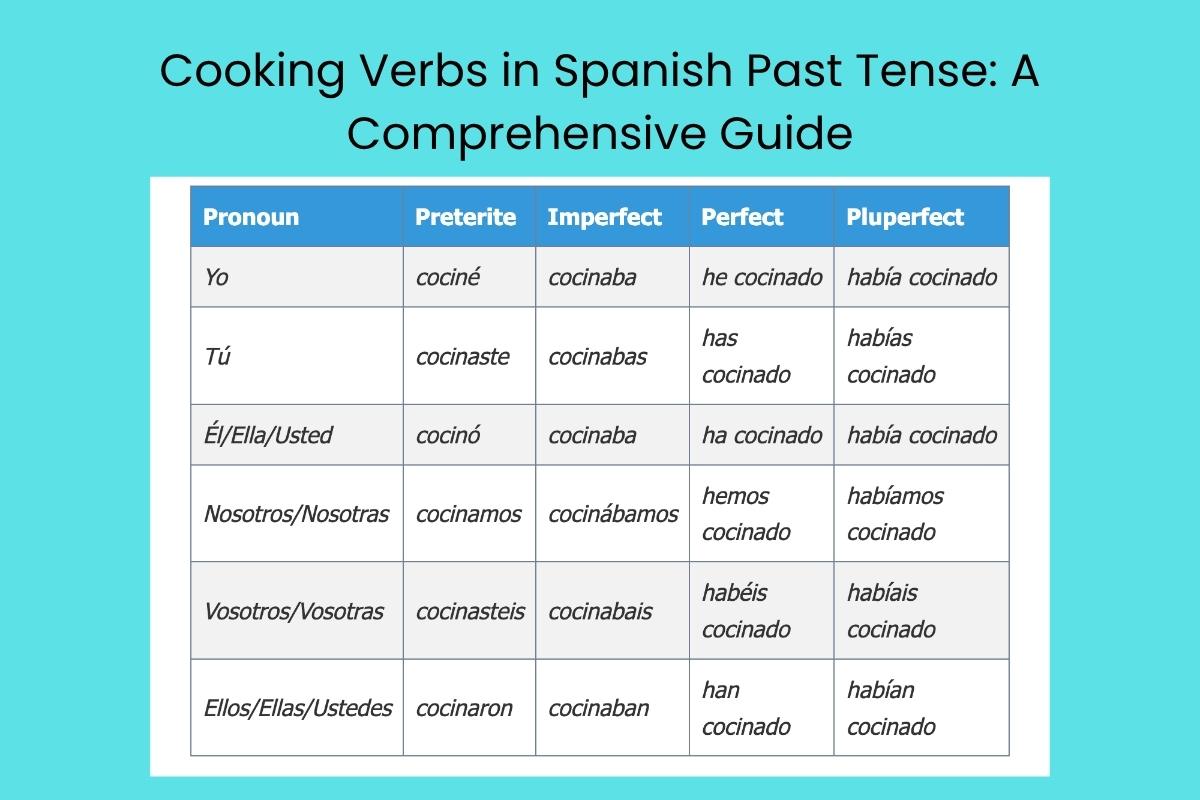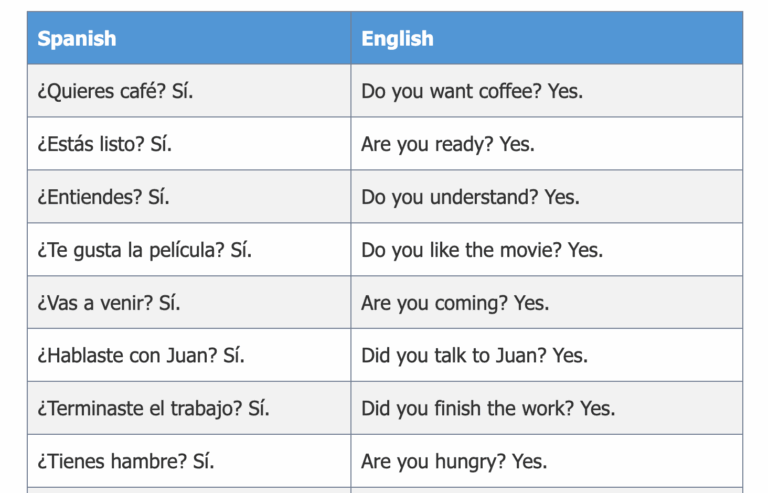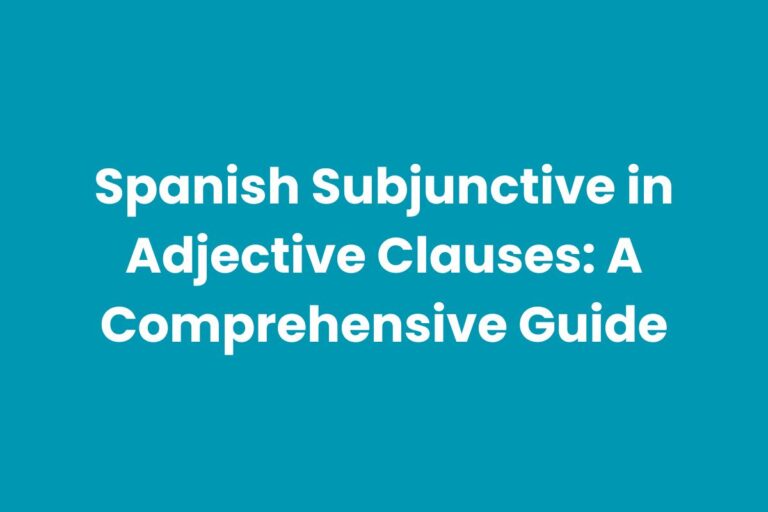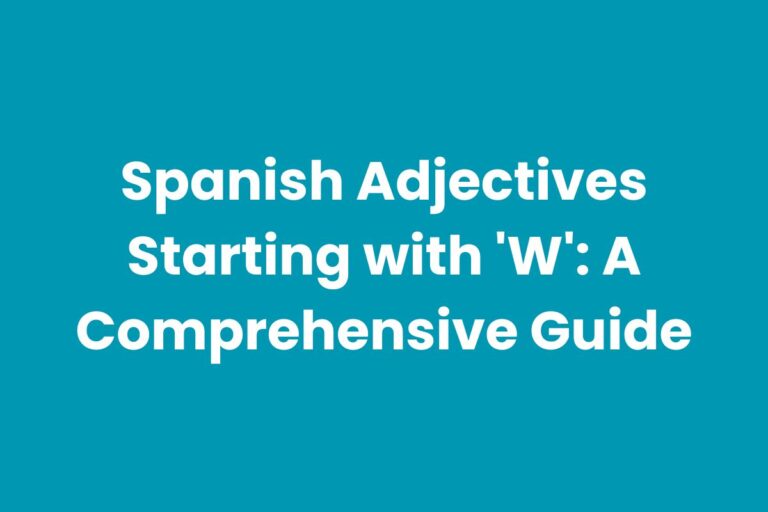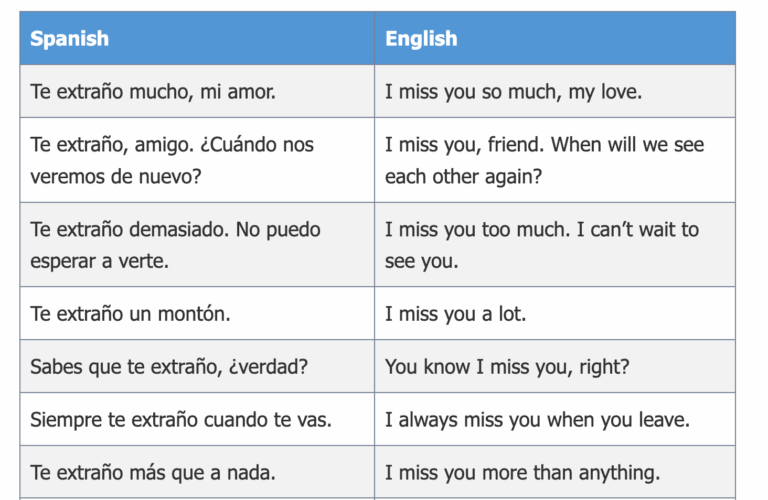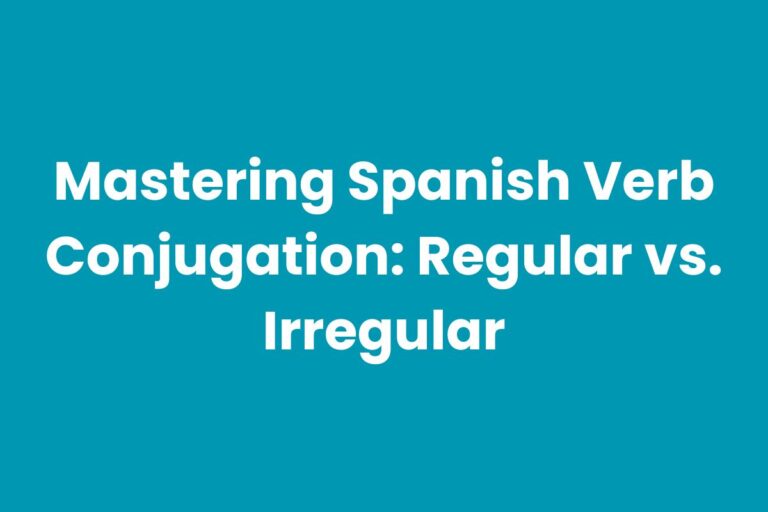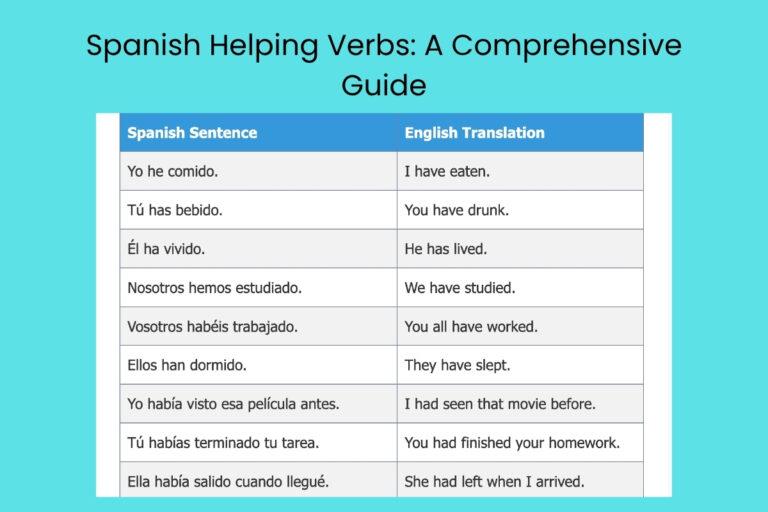Cooking Verbs in Spanish Past Tense: A Comprehensive Guide
Mastering the past tense of cooking verbs in Spanish is crucial for anyone looking to discuss culinary experiences, share recipes, or simply talk about what they ate. This article provides a complete guide to conjugating and using cooking-related verbs in the Spanish past tense, covering regular and irregular verbs, different past tenses, and common mistakes.
Whether you’re a beginner or an advanced learner, this guide will help you confidently express your culinary adventures in Spanish.
Table of Contents
- Introduction
- Definition of Past Tense in Spanish
- Structural Breakdown of Past Tense Conjugations
- Types of Past Tenses in Spanish
- Examples of Cooking Verbs in Past Tense
- Usage Rules for Past Tenses
- Common Mistakes
- Practice Exercises
- Advanced Topics
- FAQ
- Conclusion
Introduction
Spanish, a vibrant and expressive language, offers a rich tapestry of verb tenses to convey actions in the past. Understanding how to conjugate and use verbs related to cooking in the past tense is essential for anyone looking to communicate effectively about food, recipes, and culinary experiences.
This guide delves into the intricacies of the Spanish past tense, specifically focusing on verbs commonly used in the context of cooking. From describing a simple meal preparation to recounting elaborate culinary adventures, mastering these verb tenses will significantly enhance your ability to express yourself in Spanish.
This article is designed for learners of all levels, from beginners who are just starting to grasp the basics of Spanish grammar to advanced speakers looking to refine their knowledge. We will cover the different types of past tenses, explore regular and irregular verbs, and provide plenty of examples to illustrate how these verbs are used in real-world contexts.
By the end of this guide, you will have a solid understanding of how to use cooking verbs in the Spanish past tense, enabling you to confidently discuss your culinary experiences with others.
Definition of Past Tense in Spanish
In Spanish, the past tense is a category of verb tenses used to describe actions or states that occurred before the present moment. The past tense is not a single entity but a group of tenses, each with its own specific nuances and uses.
These tenses allow speakers to convey when an action happened, how long it lasted, and its relationship to other events in the past. Understanding these distinctions is key to mastering the Spanish language.
The past tense in Spanish can be broadly classified into simple and compound tenses. Simple tenses involve a single verb form, while compound tenses use an auxiliary verb (usually haber) combined with the past participle of the main verb. Furthermore, each past tense has a specific function. For example, the preterite is used for completed actions, while the imperfect is used for habitual or ongoing actions in the past. The choice of which past tense to use depends on the context and the specific meaning you want to convey.
Structural Breakdown of Past Tense Conjugations
Spanish verb conjugations in the past tense are based on the verb’s infinitive ending (-ar, -er, or -ir). Each tense has its own set of endings that are added to the verb stem, which is obtained by removing the infinitive ending.
Regular verbs follow predictable patterns, making them easier to conjugate. Irregular verbs, on the other hand, have unique conjugations that must be memorized.
Let’s break down the general structure:
- Identify the infinitive: For example, cocinar (to cook), comer (to eat), vivir (to live).
- Determine the verb stem: Remove the infinitive ending (-ar, -er, -ir). For example, cocin-, com-, viv-.
- Add the appropriate past tense ending: This depends on the tense (preterite, imperfect, etc.) and the subject pronoun (yo, tú, él/ella/usted, nosotros, vosotros, ellos/ellas/ustedes).
For example, let’s conjugate the regular verb cocinar (to cook) in the preterite tense:
- Yo: cociné (I cooked)
- Tú: cocinaste (You cooked)
- Él/Ella/Usted: cocinó (He/She/You cooked)
- Nosotros/Nosotras: cocinamos (We cooked)
- Vosotros/Vosotras: cocinasteis (You all cooked)
- Ellos/Ellas/Ustedes: cocinaron (They/You all cooked)
Types of Past Tenses in Spanish
Spanish has several past tenses, each with its own specific nuances and uses. The most common past tenses are the preterite, the imperfect, the perfect, and the pluperfect.
Understanding the differences between these tenses is crucial for mastering the Spanish language and expressing yourself accurately.
Preterite (Pretérito Indefinido)
The preterite tense is used to describe completed actions in the past. It is used for actions that had a definite beginning and end and that are seen as finished.
It is often used to narrate events in the past.
Example: Ayer cociné una paella. (Yesterday I cooked a paella.)
Imperfect (Pretérito Imperfecto)
The imperfect tense is used to describe ongoing or habitual actions in the past. It is used for actions that did not have a definite beginning or end and that are seen as continuing or repeated.
It is also used to describe states of being or conditions in the past.
Example: Cuando era niño, comía mucha sopa. (When I was a child, I used to eat a lot of soup.)
Perfect (Pretérito Perfecto)
The perfect tense is used to describe actions that have been completed recently or that have a relevance to the present. It is formed with the auxiliary verb haber (to have) in the present tense plus the past participle of the main verb.
Example: Hoy he preparado un pastel delicioso. (Today I have prepared a delicious cake.)
Pluperfect (Pretérito Pluscuamperfecto)
The pluperfect tense is used to describe actions that had been completed before another action in the past. It is formed with the auxiliary verb haber (to have) in the imperfect tense plus the past participle of the main verb.
Example: Antes de llegar a la fiesta, ya había comido. (Before arriving at the party, I had already eaten.)
Examples of Cooking Verbs in Past Tense
Let’s explore some common cooking verbs and see how they are conjugated in the different past tenses. We will cover regular verbs, irregular verbs, and reflexive verbs.
Regular Verbs
Regular verbs follow predictable conjugation patterns. Here are some examples of regular cooking verbs in the past tense:
Cocinar (to cook)
| Pronoun | Preterite | Imperfect | Perfect | Pluperfect |
|---|---|---|---|---|
| Yo | cociné | cocinaba | he cocinado | había cocinado |
| Tú | cocinaste | cocinabas | has cocinado | habías cocinado |
| Él/Ella/Usted | cocinó | cocinaba | ha cocinado | había cocinado |
| Nosotros/Nosotras | cocinamos | cocinábamos | hemos cocinado | habíamos cocinado |
| Vosotros/Vosotras | cocinasteis | cocinabais | habéis cocinado | habíais cocinado |
| Ellos/Ellas/Ustedes | cocinaron | cocinaban | han cocinado | habían cocinado |
Hornear (to bake)
| Pronoun | Preterite | Imperfect | Perfect | Pluperfect |
|---|---|---|---|---|
| Yo | horneé | horneaba | he horneado | había horneado |
| Tú | horneaste | horneabas | has horneado | habías horneado |
| Él/Ella/Usted | horneó | horneaba | ha horneado | había horneado |
| Nosotros/Nosotras | horneamos | horneábamos | hemos horneado | habíamos horneado |
| Vosotros/Vosotras | horneasteis | horneabais | habéis horneado | habíais horneado |
| Ellos/Ellas/Ustedes | hornearon | horneaban | han horneado | habían horneado |
Freír (to fry) Note: While *freír* is irregular, it’s included here for comparison.
| Pronoun | Preterite | Imperfect | Perfect | Pluperfect |
|---|---|---|---|---|
| Yo | freí | freía | he freído | había freído |
| Tú | freíste | freías | has freído | habías freído |
| Él/Ella/Usted | frió | freía | ha freído | había freído |
| Nosotros/Nosotras | freímos | freíamos | hemos freído | habíamos freído |
| Vosotros/Vosotras | freísteis | freíais | habéis freído | habíais freído |
| Ellos/Ellas/Ustedes | frieron | freían | han freído | habían freído |
Irregular Verbs
Irregular verbs have unique conjugations that do not follow the standard patterns. These verbs often have stem changes or completely different forms in certain tenses.
Here are some common irregular cooking verbs:
Hacer (to make/do)
| Pronoun | Preterite | Imperfect | Perfect | Pluperfect |
|---|---|---|---|---|
| Yo | hice | hacía | he hecho | había hecho |
| Tú | hiciste | hacías | has hecho | habías hecho |
| Él/Ella/Usted | hizo | hacía | ha hecho | había hecho |
| Nosotros/Nosotras | hicimos | hacíamos | hemos hecho | habíamos hecho |
| Vosotros/Vosotras | hicisteis | hacíais | habéis hecho | habíais hecho |
| Ellos/Ellas/Ustedes | hicieron | hacían | han hecho | habían hecho |
Poner (to put/place)
| Pronoun | Preterite | Imperfect | Perfect | Pluperfect |
|---|---|---|---|---|
| Yo | puse | ponía | he puesto | había puesto |
| Tú | pusiste | ponías | has puesto | habías puesto |
| Él/Ella/Usted | puso | ponía | ha puesto | había puesto |
| Nosotros/Nosotras | pusimos | poníamos | hemos puesto | habíamos puesto |
| Vosotros/Vosotras | pusisteis | poníais | habéis puesto | habíais puesto |
| Ellos/Ellas/Ustedes | pusieron | ponían | han puesto | habían puesto |
Venir (to come)
| Pronoun | Preterite | Imperfect | Perfect | Pluperfect |
|---|---|---|---|---|
| Yo | vine | venía | he venido | había venido |
| Tú | viniste | venías | has venido | habías venido |
| Él/Ella/Usted | vino | venía | ha venido | había venido |
| Nosotros/Nosotras | vinimos | veníamos | hemos venido | habíamos venido |
| Vosotros/Vosotras | vinisteis | veníais | habéis venido | habíais venido |
| Ellos/Ellas/Ustedes | vinieron | venían | han venido | habían venido |
Reflexive Verbs
Reflexive verbs are used when the subject performs an action on themselves. They require the use of reflexive pronouns (me, te, se, nos, os, se). Here’s an example with prepararse (to prepare oneself):
Prepararse (to prepare oneself)
| Pronoun | Preterite | Imperfect | Perfect | Pluperfect |
|---|---|---|---|---|
| Yo | me preparé | me preparaba | me he preparado | me había preparado |
| Tú | te preparaste | te preparabas | te has preparado | te habías preparado |
| Él/Ella/Usted | se preparó | se preparaba | se ha preparado | se había preparado |
| Nosotros/Nosotras | nos preparamos | nos preparábamos | nos hemos preparado | nos habíamos preparado |
| Vosotros/Vosotras | os preparasteis | os preparabais | os habéis preparado | os habíais preparado |
| Ellos/Ellas/Ustedes | se prepararon | se preparaban | se han preparado | se habían preparado |
Usage Rules for Past Tenses
Understanding the nuances of when to use each past tense is crucial for effective communication in Spanish. Each tense carries a specific meaning and is used in particular contexts.
Preterite Usage
The preterite tense is used for:
- Completed actions with a definite beginning and end: Ayer comí pizza. (Yesterday I ate pizza.)
- Actions that occurred at a specific time: El año pasado viajé a España. (Last year I traveled to Spain.)
- A series of completed actions: Primero corté las verduras, luego las cociné y finalmente las serví. (First I cut the vegetables, then I cooked them, and finally I served them.)
Imperfect Usage
The imperfect tense is used for:
- Ongoing or habitual actions in the past: Cuando era niño, comía helado todos los días. (When I was a child, I used to eat ice cream every day.)
- Describing states of being or conditions in the past: Hacía mucho calor ayer. (It was very hot yesterday.)
- Describing simultaneous actions in the past: Mientras yo cocinaba, mi hermano lavaba los platos. (While I was cooking, my brother was washing the dishes.)
Perfect Usage
The perfect tense is used for:
- Actions that have been completed recently: Hoy he bebido mucho café. (Today I have drunk a lot of coffee.)
- Actions that have a relevance to the present: Nunca he comido sushi. (I have never eaten sushi.)
Pluperfect Usage
The pluperfect tense is used for:
- Actions that had been completed before another action in the past: Cuando llegué a la cena, ya habían comido todos. (When I arrived at the dinner, everyone had already eaten.)
Common Mistakes
One of the most common mistakes is confusing the preterite and imperfect tenses. Here are some examples of common errors and how to correct them:
| Incorrect | Correct | Explanation |
|---|---|---|
| Ayer comía pizza. | Ayer comí pizza. | The preterite is needed to describe a completed action (eating pizza yesterday). |
| Cuando era niño, comí helado todos los días. | Cuando era niño, comía helado todos los días. | The imperfect is needed to describe a habitual action (eating ice cream every day as a child). |
| Hoy bebí mucho café. | Hoy he bebido mucho café. | The perfect tense is needed to describe an action that has relevance to the present (drinking coffee today). |
| Cuando llegué a la cena, ya comieron todos. | Cuando llegué a la cena, ya habían comido todos. | The pluperfect is needed to describe an action completed before another action in the past (eating before I arrived). |
Practice Exercises
Test your knowledge with these practice exercises. Fill in the blanks with the correct past tense form of the verb in parentheses.
Exercise 1: Preterite vs. Imperfect
| Question | Answer |
|---|---|
| 1. Ayer yo ________ (cocinar) una tarta de manzana. | 1. cociné |
| 2. Cuando era joven, yo ________ (comer) mucha fruta. | 2. comía |
| 3. El año pasado nosotros ________ (viajar) a Italia. | 3. viajamos |
| 4. Antes, ella ________ (preparar) la cena cada noche. | 4. preparaba |
| 5. La semana pasada, ellos ________ (ir) al supermercado. | 5. fueron |
| 6. De niño, él ________ (jugar) al fútbol todos los días. | 6. jugaba |
| 7. Anoche, nosotros ________ (ver) una película interesante. | 7. vimos |
| 8. Antes, tú ________ (estudiar) español en la universidad. | 8. estudiabas |
| 9. El mes pasado, yo ________ (leer) un libro muy bueno. | 9. leí |
| 10. Cuando vivía en España, yo ________ (salir) con mis amigos cada fin de semana. | 10. salía |
Exercise 2: Perfect vs. Pluperfect
| Question | Answer |
|---|---|
| 1. Hoy yo ________ (comer) una ensalada saludable. | 1. he comido |
| 2. Antes de salir, yo ya ________ (preparar) mi almuerzo. | 2. había preparado |
| 3. Esta semana nosotros ________ (visitar) muchos restaurantes nuevos. | 3. hemos visitado |
| 4. Antes de la fiesta, ella ________ (hacer) un pastel delicioso. | 4. había hecho |
| 5. Este mes ellos ________ (probar) muchos platos diferentes. | 5. han probado |
| 6. Antes de llegar, él ya ________ (beber) dos vasos de agua. | 6. había bebido |
| 7. Hoy nosotros ________ (aprender) mucho sobre la cocina española. | 7. hemos aprendido |
| 8. Antes de ir al cine, tú ________ (ver) el tráiler de la película. | 8. habías visto |
| 9. Este año, yo ________ (cocinar) muchas recetas nuevas. | 9. he cocinado |
| 10. Antes de empezar a trabajar, yo ________ (desayunar) un plato de fruta. | 10. había desayunado |
Exercise 3: Mixed Past Tenses
| Question | Answer |
|---|---|
| 1. Cuando era niño, yo ________ (comer, imperfect) helado todos los días, pero ayer ________ (comer, preterite) solo uno. | 1. comía, comí |
| 2. Antes de que llegaras, yo ya ________ (preparar, pluperfect) la cena, y hoy ________ (preparar, perfect) algo especial. | 2. había preparado, he preparado |
| 3. El año pasado nosotros ________ (viajar, preterite) a España y ________ (visitar, preterite) muchos lugares interesantes. | 3. viajamos, visitamos |
| 4. De niño, él ________ (jugar, imperfect) al fútbol, pero ayer ________ (jugar, preterite) al baloncesto. | 4. jugaba, jugó |
| 5. Antes, ella ________ (cocinar, imperfect) la cena cada noche, pero hoy ________ (pedir, perfect) comida para llevar. | 5. cocinaba, ha pedido |
| 6. La semana pasada, ellos ________ (ir, preterite) al supermercado porque ________ (necesitar, imperfect) ingredientes para la receta. | 6. fueron, necesitaban |
| 7. Anoche, nosotros ________ (ver, preterite) una película interesante después de que ya ________ (cenar, pluperfect). | 7. vimos, habíamos cenado |
| 8. Antes, tú ________ (estudiar, imperfect) español, y ahora ________ (hablar, perfect) muy bien. | 8. estudiabas, has hablado |
| 9. El mes pasado, yo ________ (leer, preterite) un libro muy bueno, y esta semana ________ (empezar, perfect) otro. | 9. leí, he empezado |
| 10. Cuando vivía en España, yo ________ (salir, imperfect) con mis amigos, y hoy ________ (recordar, perfect) esos momentos. | 10. salía, he recordado |
Advanced Topics
For advanced learners, let’s delve into more complex aspects of the Spanish past tense, including subjunctive past tenses and compound tenses.
Subjunctive Past Tenses
The subjunctive mood is used to express doubt, uncertainty, wishes, or emotions. The past subjunctive has two forms: the imperfect subjunctive and the pluperfect subjunctive.
These tenses are often used in subordinate clauses after expressions of doubt, desire, or emotion.
Example (Imperfect Subjunctive): Quería que cocinaras la cena. (I wanted you to cook dinner.)
Example (Pluperfect Subjunctive): Dudaba que hubieras cocinado la cena. (I doubted that you had cooked dinner.)
Compound Tenses
Besides the perfect and pluperfect, Spanish has other compound tenses that combine the auxiliary verb haber with the past participle. These tenses are used to express more complex relationships between actions in time.
Example (Future Perfect): Para mañana, ya habré cocinado todo. (By tomorrow, I will have cooked everything.)
Example (Conditional Perfect): Habría cocinado si hubiera tenido los ingredientes. (I would have cooked if I had had the ingredients.)
FAQ
- What is the difference between the preterite and the imperfect tense?
The preterite is used for completed actions with a definite beginning and end, while the imperfect is used for ongoing or habitual actions in the past.
- When should I use the perfect tense?
Use the perfect tense to describe actions that have been completed recently or that have a relevance to the present.
- What is the pluperfect tense used for?
The pluperfect tense is used to describe actions that had been completed before another action in the past.
- How do I conjugate irregular verbs in the past tense?
Irregular verbs have unique conjugations that do not follow the standard patterns. You need to memorize these conjugations.
- What are reflexive verbs and how are they used in the past tense?
Reflexive verbs are used when the subject performs an action on themselves. They require the use of reflexive pronouns (me, te, se, nos, os, se) and are conjugated with the appropriate past tense endings.
- Can you give an example of when to use the imperfect subjunctive?
The imperfect subjunctive is often used in subordinate clauses after expressions of doubt, desire, or emotion. For example, Quería que cocinaras la cena. (I wanted you to cook dinner.)
- What is the difference between ‘ser’ and ‘estar’ in the past imperfect?
Both “ser” and “estar” have unique imperfect forms. “Ser” (era, eras, era, éramos, erais, eran) describes inherent qualities or characteristics. “Estar” (estaba, estabas, estaba, estábamos, estabais, estaban) describes temporary states, conditions, locations or feelings.
- Is it important to learn the past participle forms for compound tenses?
Yes, it is crucial. The past participle is used with the auxiliary verb “haber” to form the perfect, pluperfect, and other compound tenses. Many verbs have irregular past participles,
and knowing these forms is essential for correct conjugation.
Conclusion
Mastering the past tense of cooking verbs in Spanish is essential for effective communication about culinary experiences. By understanding the nuances of the preterite, imperfect, perfect, and pluperfect tenses, as well as the conjugations of regular and irregular verbs, you can confidently discuss your culinary adventures in Spanish.
Remember to practice regularly and pay attention to the context in which each tense is used. With dedication and perseverance, you will be able to express yourself fluently and accurately when talking about cooking and food in Spanish.

